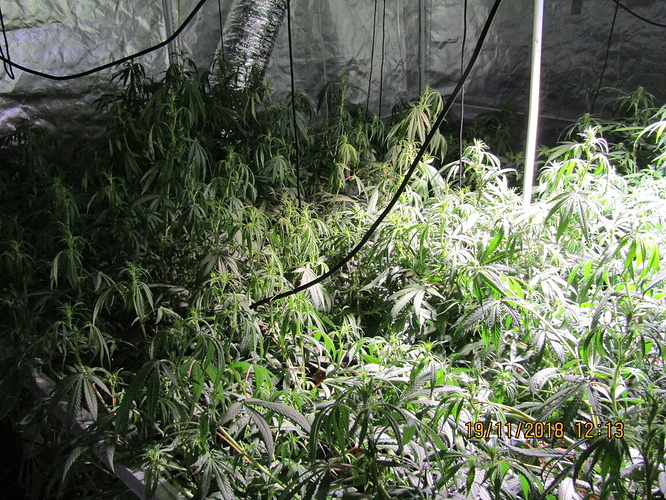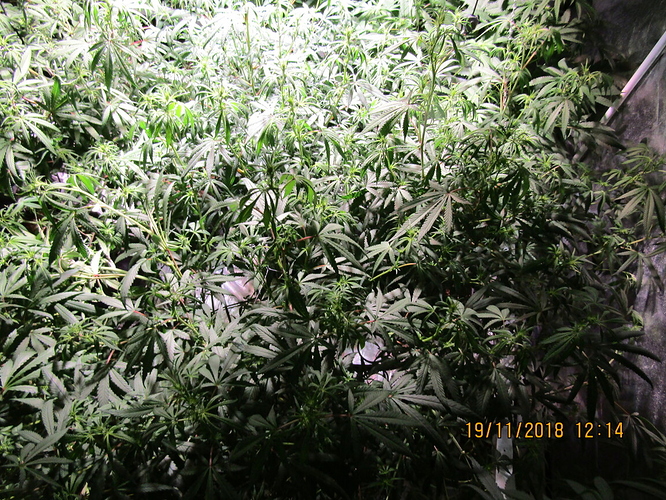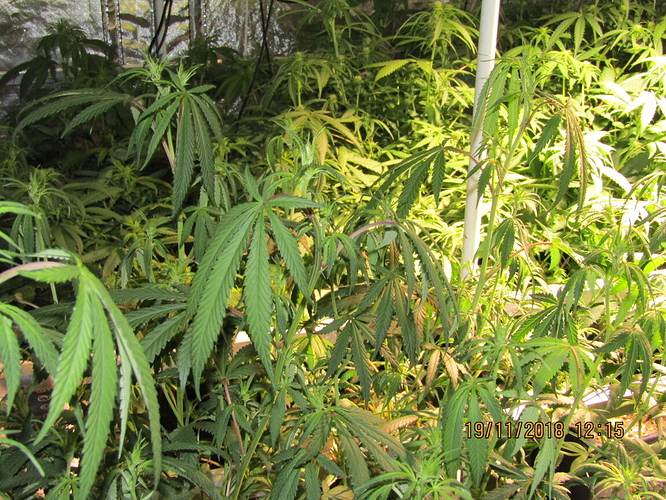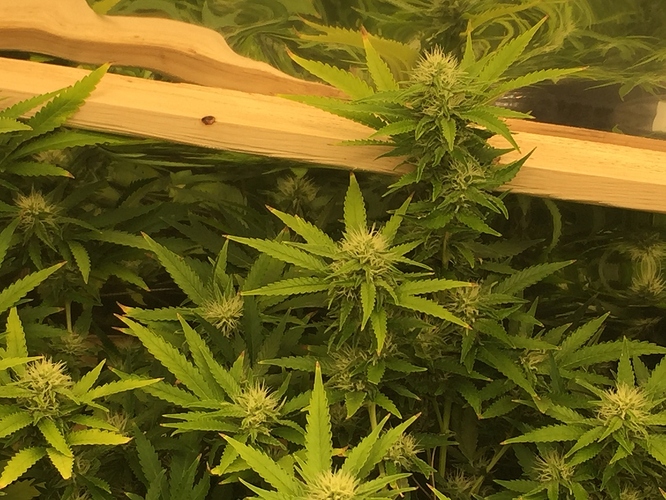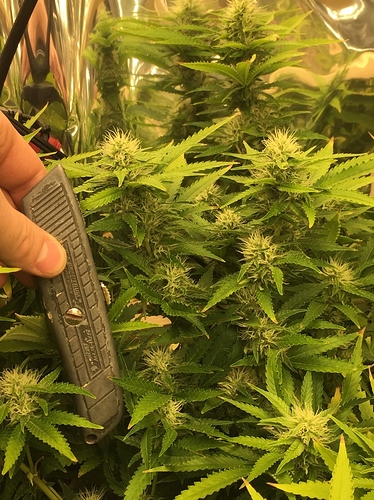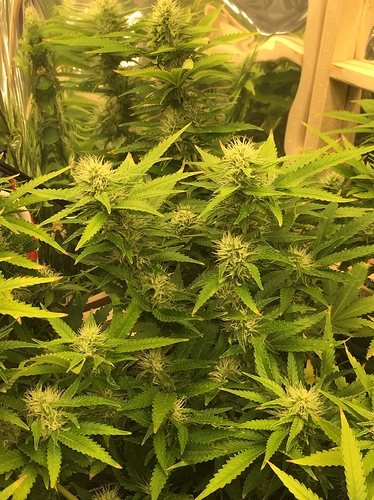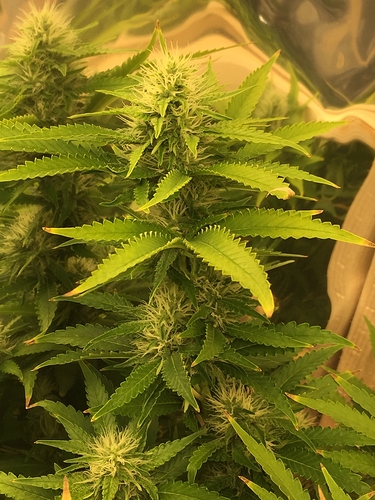I’m assuming, I don’t know, that that is the correct pH. I know it is for hydro. Tag me when you post pictures tomorrow. I generally run my grow room cooler, but I think you are alright. @garrigan62 could help you with this better than I can. He should be along shortly with an answer
Thanks.
garrigan65 helped me my last problem. he’s a legend…
I’ll quickly get some pic’s . be back soon. This is so important to sort.
Here are the pic’s and my commentary.
Decide to quicky do a flush on 2 plants. PH in 5.8
Plant1 10l bucket ph out 6.2 , Using 3 * 10l flush’s. 1st run ec 2.0, 2nd bucket 1.8, 3rd, .09 .
Plant 2. 6.2 2.2 1.9 1.
Also notices the second buckets medium was finer and held water more.
Waterlogged pots, and too much fert.
My solution. Flush all buckets to using ph water .5.8 until water runs out at .02 as it was before going in.
Let pots dry then carefully add new fert.
Question. Can I get the garden which has a ph value of 7.2 and use that to flush?/
What do you guys think?
I don’t know @raustin, what do you think? I got lost at flushing
They look a little droopy probably from the flush, but they look good. Sorry I didn’t read very far up, so I don’t know the problem.
only flushed 2 plants. Thats how they are looking. The banners are fine.
Or just let them dry out?
Here I am my friend. Droopy Leaves
One of two things going on here.
1.) Overwatering 
The problem isn’t the abundance of water, it’s the lack of oxygen, it’s just
caused by the overabundance of water. Hydro you’re pumping oxygen in the water
or doing some kind of come and go system with your water…Im not a hydro guy
I’m not an expert on their methods lol
But If you don’t have proper drainage in coco and you’re watering too often,
you can have over watering. Let them dry out and reduce your watering/feeding
schedule. Or, Add more perlite or hydroton rocks to your coco to air it out more
and allow more drainage. Good luck
The best way to use coco is with fabric pots and no mix 100% coco. :leaf:
Coco coir is a soil-less growing medium which gives the experience of growing
in soil, you simply water your plants with nutrient water. Coco coir can be
treated basically the same as soil for growing cannabis and is effective at
holding onto moisture and nutrients for roots, but it also has a lighter
texture that lets it hold onto more oxygen, this helps prevent over and
under-watering. Growing in coco tends to promote healthy and fast root
development compared to other potting mixes.
2.) Nitrogen Toxic 
Nitrogen toxicity - too much nitrogen - Cannabis growing problem, Problem :
Dark green leaves, shiny leaves,
clawing, weak stems, and overall slow growth. Marijuana leaves that are
nitrogen toxic often get “The Claw”
or talon-like leaves that are bent at the ends. They also do an odd curving
(or cupping) that is often
mistaken for overwatering, but is unique to nitrogen toxicity. You can see a
“clawing” leaf pictured to
the right and more pictures below (click each picture for a close-up).
Leaves that turn into claws often start turning yellow and dying if the
nitrogen toxicity is not treated,
much like a nitrogen deficiency, only the leaves will continue to get
more and more clawed. Leaves
eventually turn yellow or brown and fall off. You can tell if yellowing
is caused by too much nitrogen
because the rest of the plant will be dark green, and the yellowing leaves
will turn into claws first.
The majority of times that growers encounter problems with nitrogen, it’s from
giving too much of it to
their plants.
Many new growers accidentally give their plants give too much Nitrogen,
especially in the flowering stage.
This results in dark, shiny, clawing leaves.
A Nitrogen toxicity can also cause certain leaves to turn yellow, but other
than that it looks nothing
like a cannabis nitrogen deficiency?
Your plant needs a lot of nitrogen in the vegetative stage, and it’s generally
hard to give too much as
long as you’re not going completely overboard with nutrients. Nitrogen is a
big part of what makes leaves
green, and is incredibly important to the process of photosynthesis (making energy from light).
But cannabis plants need relatively low levels of Nitrogen in the second
half of the flowering/budding
stage. While your plants still need N (nitrogen) during flowering, too
much N at this stage will prevent
your plants from forming buds properly, resulting in lower yields, less
potency and possibly inferior buds.
This is why it’s important to avoid any type of “time-release” nutrients or
soil (for example, standard
Miracle-Gro soil) as they will keep giving your plant a lot of N even after
its started flowering.
When it comes to nitrogen, this is what your plant needs:
Vegetative Stage - higher levels of Nitrogen (pretty much any plant food will do)
Most complete plant foods that you get at a gardening store contain high levels of nitrogen (N).
These nutrient systems tend to work well in the vegetative stage.
Some examples of cannabis-friendly one-part Vegetative nutrient systems…
Dyna - Gro “Foliage Pro”
General Hydroponics “Flora Nova Grow”
Pretty much any complete plant food
Flowering Stage - lower levels of Nitrogen (use “Bloom” or Cactus nutrients)
It’s extra important to find a nutrient system with lower levels of nitrogen for the last part
of your plant’s life. Many “Bloom” or “Flowering” style base nutrients are just the ticket.
Some examples of good one-part Flowering nutrient systems…
Dyna-Gro “Bloom”
General Hydroponics “Flora Nova Bloom”
If you can’t order online and can’t find a good one-part base Bloom formula locally, you do have
other choices. Though not an ideal choice, most Cactus plant foods will contain good nutrient
ratios for growing cannabis during the budding stage. So in a pinch, you can use the cactus
nutrients that can be found at most gardening stores.
Different strains react differently to nitrogen toxicity. Some plants get dark green leaves with
no clawing. Some strains will get leaves that do the weird 90 degree bend at the tips, while other
strains or individual plants start curling like claws and then turn yellow / brown and fall off
like a deficiency. Yet these are all signs of too much nitrogen.
Signs of Nitrogen Toxicity
This marijuana plants has been fed too much Nitrogen Dark green leaves and foliage
Leaf tips may turn down, without signs of overwatering.
You may notice yellowing on the affected leaves or other signs of nutrient deficiencies as time goes on
Nitrogen toxicity is often but not always accompanied by nutrient burn
The Claw often seems random, affecting leaves here and there
Heat and pH problems will make the clawing worse, as they stress out the plant and lower her defenses,
and cause her to drink more water (and uptake more N)
As time goes on, the claw leaves will eventually start turning yellow, getting spots, and dying
This marijuana plants has been fed too much nitrogen
Too much nitrogen causes marijuana leaves to curl down like talons Dark green leaves are a sign of
nitrogen toxicity
Image
This cannabis seedling is dark because it was underwatered in a “hot” soil mix (too much Nitrogen),
but after watering the plant as normal for a week or two, the plant started growing vigorously
Underwatered in a "hot’ (nutrient rich) starting mix led to this plant developing a nitrogen toxicity
Solution: Reduce the Nitrogen your plant is getting!
Reduce the amount of nitrogen that is being fed to the plants. If you are feeding extra nutrients, cut
down that amount. If you are in the flowering / budding stage, make sure you’re using a formula that’s
specifically meant for flowering, or else it could have too much nitrogen.
If you are not feeding extra nutrients, you may have “hot” soil that has been giving your plants extra
nutrients. In that case, flush your plants with filtered, P H 'ed water to help clear out the extra nitrogen.
Effected leaves likely won’t recover, but you should see the problem halt with no new leaves being affected.
Wait! I’m not sure if it’s Nitrogen toxicity!
Nitrogen toxicity in marijuana makes clawed leaves that look like talons Ok, you ruled out overwatering,
now what?
When I first got started growing, everyone kept telling me that this particular kind of leaf clawing
was caused by under or overwatering my plants, pH problems, or heat problems.
Yet in my case, I knew that it wasn’t over or under watering (I was growing in hydro, where roots
grow directly in water and air stones are constantly adding oxygen). I knew it wasn’t pH (my reservoir
water had the right pH) and I knew it wasn’t heat since the grow area was slightly cooler than room temperature.
So then what was really causing my claw leaves?
It’s understandable that other growers were mistaken. It is true that many stresses will make any
Plus overwatering can cause a similar kind of leaf clawing (learn more below). And if you do have
nitrogen toxicity, than heat or pH problems will make the problem much worse.
Now, you may or may not know that marijuana (or any plant) needs an element known as “Nitrogen” to grow.
In fact, nitrogen is one of the 3 nutrients that are included in almost every kind of plant food.
When looking at plant nutrients, you’ll almost always see 3 numbers listed, like 3-12-6 or 5-10-5.
These numbers represent the ratio of Nitrogen (N), Phosphorous (P) and Potassium (K) contained in
the bottle. Just about all plant life on Earth needs these 3 elements to grow.
See the nutrient numbers listed on the front?
The very first number, “3” in the case of the picture to the right, always displays the proportion
of nitrogen in this nutrient bottle compared to the other 2 nutrients (Phosphorus and Potassium
respectively).
The reason nitrogen is in all plant nutrient formulations is because it’s vital to plant processes.
For marijuana plants, when they don’t get enough nitrogen, the bottom leaves start turning yellow
and dying. Left unchecked, a nitrogen deficiency can cause the whole plant to eventually die.
However, this time we’re the dealing with the opposite problem: nitrogen toxicity, or too much nitrogen.
Why You Should Treat And Prevent Nitrogen Toxicity
Marijuana plants that get too much Nitrogen in the vegetative stage don’t grow as vigorously.
Too much nitrogen is especially harmful in the flowering stage, because this will cause your plant
to produce much smaller buds.
If you react quickly and reduce your nitrogen levels at the first sign of toxicity, your plant
will quickly recover.
Note: Some strains with the word “Claw” in the name tend to do The Claw more easily than others.
Problems with excess nitrogen are not common in the wild; it’s a lot more common to see nitrogen
toxicity on indoor plants, especially when overzealous growers go overboard with nutrients.
Occasionally you’ll come across a strain or particular plant that likes lower levels of nutrients,
and when this happens, it’s important to realize the plant is showing signs of toxicity, even if all
the other plants in your garden seem fine.
One of the most common signs off too-many-nutrients is “nutrient burn,” or when the tips of your
leaf appear brown or burned. Yet there are specific signals your plant will display when she’s
getting too much nitrogen…
Recap: How You Know You Have a Nitrogen Toxicity
Dark green leaves and foliage
Leaf tips turn down, without signs of overwatering.
You may notice yellowing on the affected leaves or other signs of nutrient deficiencies as time goes on
Nitrogen toxicity is often but not always accompanied by nutrient burn
The Claw often seems random, affecting leaves here and there
Heat and pH problems will make the clawing worse, as they stress out the plant and lower her
defenses, and cause her to drink more water (and uptake more N)
As time goes on, the claw leaves will eventually start turning yellow, getting spots, and dying
Light and “The Claw”
The distance between the leaves to the lights or irregular light patterns from reflectors often
seem to affect the condition, which is why many growers believe that light is somehow causing
the problem.
You may notice this clawing first appears on dark green leaves that aren’t getting enough light
(they aren’t able to use up all their nitrogen and become nitrogen toxic).
The Claw in the Flowering Stage
If you use vegetative plant nutrients during the flowering stage, then they’ll deliver too much nitrogen.
This is why you need to get special nutrients meant for the blooming / flowering stage. You’ll notice
that flowering nutrients always contain a smaller percentage of nitrogen (the first number) compared to
nutrients for the vegetative stage. Learn more about marijuana nutrients here.
Many growers mistakenly keep raising nutrient levels or adding additional nitrogen when they see yellow
leaves in the flowering stage, not realizing that it’s natural for plant leaves to start yellowing as
harvest approaches. Adding too much nitrogen in the flowering stage can cause nitrogen toxicity even
when you can see yellow lower leaves. Nitrogen toxicity in flowering results in smaller yields and
airy cannabis buds, so make sure to watch out!
Nitrogen toxic sativa buds Nitrogen toxicity in flowering will reduce bud size Nitrogen toxic
marijuana plant in flowering leaves curl down Nitrogen toxicity - too much nitrogen - Cannabis
growing problem
Note: During the last few weeks before harvest, marijuana plants starts pulling all the remaining
nitrogen from her leaves as part of the bud-making process. This causes yellowing leaves starting
towards the bottom of the plant. This is part of the natural flowering process and you don’t need
to fight it. You may notice that marijuana leaves are yellowing in almost all pictures of marijuana
plants with big buds that are close to harvest. You tend to get smaller yields at harvest from
nitrogen-toxic plants with dark green leaves.
It’s Normal For Marijuana Leaves To Start Turning Yellow As Harvest Time Approaches, Don’t Keep
Adding More Nitrogen!
Marijuana plant ready for harvest, notice the yellowing leave’s , which is a natural part of the
ripening process It’s common for leaves to turn yellow towards the end of the flowering stage,
no need to fight it!
I know a lot of marijuana plant problems can look similar, but now that you’re armed with the
right information, you’ll know exactly what to do if you see Nitrogen Toxicity affecting your
marijuana plants.
Nitrogen toxicity - Dark, curled, claw or talon leaves
Leaf Color:
Edges Appear Brown or Burnt
Yellow Leaves - Lower, older leaves
Dark or Purple Leaves
Brown or Dark Spots
Leaf Symptoms:
Upper Leaves / Newer Growth Affected
Lower Leaves / Older Growth Affected
All Leaves Seem Affected
Leaf Edges Appear Burnt
Leaf Tips Appear Burnt
Spots
Leaves Curl Under
Wilting / Drooping
Plant Symptoms:
Weak Stems
Leaves Curl Under
Plant Wilting / Drooping
Other Symptoms:
Buds Not Fattening
Hi Garrigan65,
Much appreciate your help…
I think its a bit of both but more likely too much watering. I am using those Autopots. Thought I’d give them ago…
Was looking at them last night and they had perked up somewhat. So plan is to let them dry out , give them a light flush them back on the fert program. The other option if it was more serious was to place airdomes in the pots, but that was a major. I used to airdomes from Autopots last time. Half the plants with. half withouit. The ones without produced better.
Autopot Problems.
-
if one valve in the pot blocks or stays open because its a gravity system you flood your room. Has happened atleast 4 times 200l plus each time. grrrrrrrr.
-
Medium must be coarse more than the 50/50 coco perlite they recommend.
-
Flushing lines essential.
Thanks once again
Hi, I’m a first-timer, following this topic. I re-potted a plant today, from 5 to 10 gallon cloth. Transfer was fine, but I added a mixture of ProMix( I’d never used it before, my FIRST time), and mixed worm castings and a couple of tsp. of dried blood. Tonite…SERIOUS YELLOWING of fan leaves…![]()
![]()
![]()
![]()
![]()
Too much nitrogen?
Thank you!
Hi @DD214 and welcome. Raustin is not with us any longer. I’m hydro, but I bet @Myfriendis410 can help.
It would be much better to start your own thread which will get you lots of traffic.
Cant you do a run off test by ph ing water to the desired level… say 5.8 and seeing what comes out? If its 6.8 you know you are high, if its 5.2 you know you are low?
Just wanna say I love the name bro. Not grow related, but I see you.
